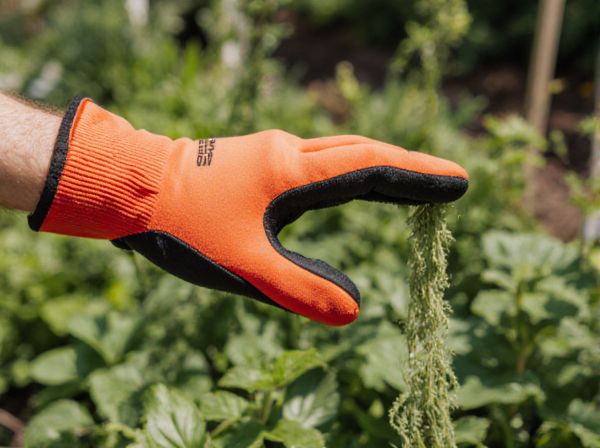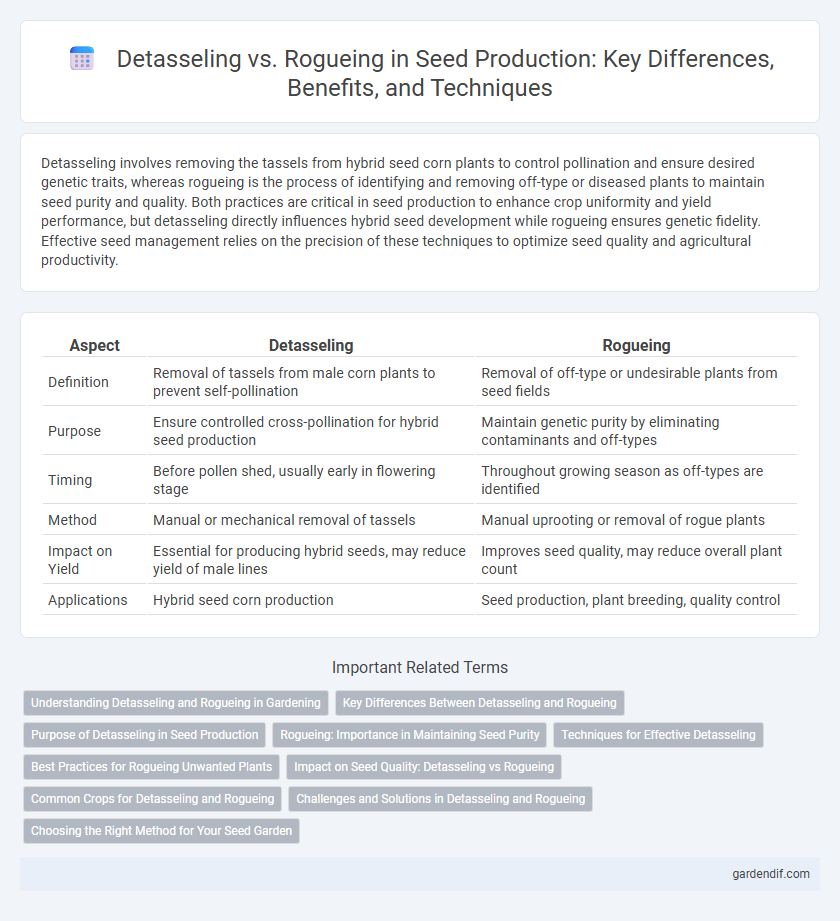
Detasseling vs Rogueing Illustration
Detasseling involves removing the tassels from hybrid seed corn plants to control pollination and ensure desired genetic traits, whereas rogueing is the process of identifying and removing off-type or diseased plants to maintain seed purity and quality. Both practices are critical in seed production to enhance crop uniformity and yield performance, but detasseling directly influences hybrid seed development while rogueing ensures genetic fidelity. Effective seed management relies on the precision of these techniques to optimize seed quality and agricultural productivity.
Table of Comparison
| Aspect | Detasseling | Rogueing |
|---|---|---|
| Definition | Removal of tassels from male corn plants to prevent self-pollination | Removal of off-type or undesirable plants from seed fields |
| Purpose | Ensure controlled cross-pollination for hybrid seed production | Maintain genetic purity by eliminating contaminants and off-types |
| Timing | Before pollen shed, usually early in flowering stage | Throughout growing season as off-types are identified |
| Method | Manual or mechanical removal of tassels | Manual uprooting or removal of rogue plants |
| Impact on Yield | Essential for producing hybrid seeds, may reduce yield of male lines | Improves seed quality, may reduce overall plant count |
| Applications | Hybrid seed corn production | Seed production, plant breeding, quality control |
Understanding Detasseling and Rogueing in Gardening
Detasseling involves the selective removal of tassels from hybrid corn plants to control pollination and ensure seed purity. Rogueing refers to identifying and removing diseased, off-type, or unwanted plants from seed fields to maintain genetic integrity and crop quality. Both practices are crucial in seed production for optimizing yield, preventing cross-contamination, and preserving desired plant traits.
Key Differences Between Detasseling and Rogueing
Detasseling involves removing the tassels from corn plants to control pollination and produce hybrid seed, whereas rogueing focuses on identifying and removing off-type or contaminated plants to maintain genetic purity. Detasseling directly influences seed production by preventing self-pollination, while rogueing ensures uniformity and quality by eliminating undesirable traits. Both practices are crucial for optimizing crop genetics but serve distinct roles in seed production management.
Purpose of Detasseling in Seed Production
Detasseling plays a crucial role in hybrid seed production by promoting cross-pollination between selected parent lines, ensuring genetic uniformity and vigor in the resulting seed. Unlike rogueing, which involves removing off-type or undesirable plants to maintain genetic purity, detasseling specifically removes the male flower parts to control pollen flow. This controlled pollination process enhances hybrid seed quality and yield by preventing self-pollination and encouraging desired genetic combinations.
Rogueing: Importance in Maintaining Seed Purity
Rogueing plays a critical role in maintaining seed purity by systematically removing off-type or undesirable plants from seed production fields, ensuring genetic consistency and high-quality crop yields. Unlike detasseling, which mainly promotes hybrid vigor by controlling pollen flow, rogueing directly eliminates genetic contaminants that could compromise seed integrity. Effective rogueing enhances seed uniformity, maximizes germination rates, and supports the production of certified seeds meeting industry standards.
Techniques for Effective Detasseling
Effective detasseling techniques involve selectively removing tassels from corn plants to control pollination and improve hybrid seed production. Precision in identifying and stripping only the male tassels of designated plants maximizes genetic purity and boosts yield. Regular monitoring and skilled hand removal remain critical to enhancing detasseling efficiency and seed quality.
Best Practices for Rogueing Unwanted Plants
Rogueing unwanted plants involves systematically identifying and removing off-type or diseased plants to maintain genetic purity and crop quality, which is critical in seed production. Best practices for rogueing include frequent field inspections during key growth stages, accurate tagging of rogue plants, and careful removal to prevent cross-contamination while preserving the surrounding healthy crop. Employing trained personnel and utilizing precision tools enhances rogueing effectiveness, ensuring optimal seed yield and varietal integrity.
Impact on Seed Quality: Detasseling vs Rogueing
Detasseling enhances seed quality by promoting cross-pollination, resulting in hybrid vigor and uniformity in seed traits. Rogueing improves seed purity by removing off-type or genetically inferior plants, reducing contamination and preserving desired genetic characteristics. Both practices are critical for optimizing seed quality but target different aspects of genetic improvement and seed performance.
Common Crops for Detasseling and Rogueing
Corn is the most common crop for detasseling, a process crucial for hybrid seed production to ensure controlled pollination. Rogueing primarily targets crops like cotton, tomatoes, and potatoes to remove off-type or diseased plants, maintaining genetic purity and crop quality. Both techniques are essential in seed production for optimizing yield and preserving desired traits in commercial agriculture.
Challenges and Solutions in Detasseling and Rogueing
Detasseling faces challenges such as labor shortages and the physical strain on workers, requiring mechanized equipment and scheduling optimization to maintain efficiency. Rogueing contends with accurately identifying and removing off-type or diseased plants, which is mitigated through advanced genetic testing and training programs for field scouts. Both processes demand continuous innovation in technology and workforce management to ensure seed purity and crop yield.
Choosing the Right Method for Your Seed Garden
Detasseling involves removing the tassels from male corn plants to control pollination and improve hybrid seed production, making it ideal for large-scale seed gardens. Rogueing focuses on identifying and removing off-type or diseased plants to maintain genetic purity and seed quality, essential for maintaining seed integrity. Selecting the right method depends on your specific crop goals--detasseling enhances hybrid vigor, while rogueing ensures uniformity and disease resistance.
Detasseling vs Rogueing Infographic

 gardendif.com
gardendif.com